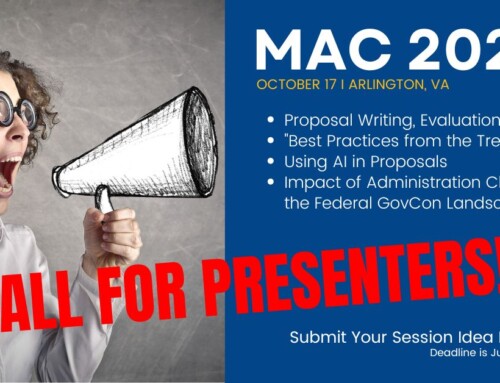Originally published in Solutioneering’s Points of View.
Know Thyself
Socrates, the classical Greek philosopher, said, “Know thyself.” Consider this related quote: “The successful company is the one that finds out what is the matter with its business before its competitors do.” This bit of wisdom comes from a principled and successful entrepreneur who co-founded a company operating in the federal government contracting (GovCon) space until it was acquired—at an impressive price of $236.95 per share!
Other companies look at, study, and analyze your flaws from the day you win a contract. You need to be doing the same to them as well. A key component of this is conducting a competitive assessment.
There are many upfront considerations when conducting a competitive assessment. For example:
❑ Relevant contracts that competitors have won in the same space in the past 3 to 5 years.
❑ Contract profiles (e.g., scope, size, duration).
❑ Award price for competitor wins and submitted price for losses. Note: You can get this information via Freedom of Information Act (FOIA) requests.
❑ Competitor performance on won contracts (i.e., success of technical/management approach or deployed solution, issues or failures, contract defaults, or litigation issues).
❑ For product-based solutions, how was the solution created (i.e., in-house transfer solution, commercial-off-the-shelf product, or ground-up development)?
❑ The competitor’s solution technology (e.g., Oracle, open-source, proprietary). ❑ The competitor’s footprint in the target customer space or industry.
❑ Current and past contracts in similar customer organizations (e.g., contract start date, duration, high-level scope, partnerships, other competitors short-listed for the respective contract). ❑ Key competitor products/services used in the customer space or similar customer organizations. ❑ The competitor’s sales message (i.e., Key elevator pitch).
❑ Discriminators.
❑ Staff (i.e., Key staff who are influencing competitor’s success).
A robust competitive assessment should include the following activities:

❑ Strength, Weakness Opportunity, and Threat (SWOT) Analysis
❑ Bidder Comparisons
❑ Porter Five-Forces Analysis
❑ Black Hat Review
Together, they help identify your differentiators/discriminators compared with those of your competitors. In particular, they help you understand the risk your company mitigates for the customer and the risk that your competition induces. They help you understand the benefits you offer/value you deliver to the customer and the competition does not. You can use this insight to help shape the pursuit in your company’s favor before the customer is no longer talking to the industry and shape the deal in your company’s favor in the actual proposal response to be submitted in the following ways:
❑ Highlight your company’s strengths.
❑ Minimize your company’s weaknesses.
❑ Neutralize the likely strengths of your competitor(s).
❑ Highlight the likely weaknesses of your competitor(s).
❑ Counter how a likely competitor could exploit your company’s weaknesses.
❑ Counter how a likely competitor could neutralize your company’s strengths.
The Problem
COVID-19 stopped all of these traditionally face-to-face collaborative competitive assessment activities essential to winning a competitive pursuit like a brick wall. We are now in a post-pandemic environment, yet the remote or hybrid workforce at best is here to stay. How do we get a robust competitive assessment done, which is essential to winning a competitive pursuit, in this new environment?
The Need
There is a need for a capability to help companies perform a thorough competitive assessment in the new remote or hybrid work environment. One that provides capture managers with the analytical ability and flexibility to support win and proposal strategy formulation, solution development, and creating the overall winning value proposition to the customer. In fact, there is a need for a capture as-a-service (CaaS) capability where such things are possible.
The Benefits
The benefits of such a CaaS capability are that it would be able to:
❑ Help do the necessary “strategic thinking before writing” in the opportunity assessment, capture, and proposal planning phases of competitive pursuits.
❑ Enable better decision-making, particularly at the C-Suite level.
❑ Assist with answering the most important question when pursuing a competitive pursuit ― “Why your company?”
❑ Support the design and development of the solution for your company’s competitive response.
❑ Store the rich context of how and why a deal was bid to increase overall company value over time.
❑ Capture the company’s intellectual capital to enable future growth.
❑ Quantify the growth status of your enterprise.
❑ Lower the cost of capturing new business.
❑ Protect the customer business that your company already has.
Know the Competition Better Than It Knows You
We believe that if such a CaaS offering existed in the GovCon marketspace that companies using it would win more competition and increase their overall enterprise value. For this reason, we have developed a capture-as-a-service offering for the GovCon market space for its use, which provides the aforementioned benefits and more.





Leave A Comment